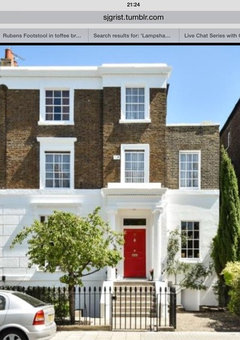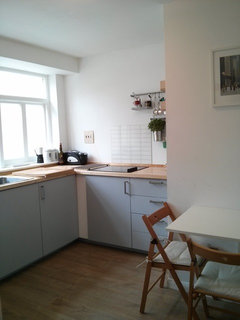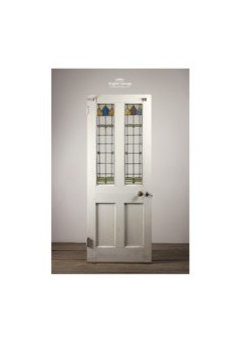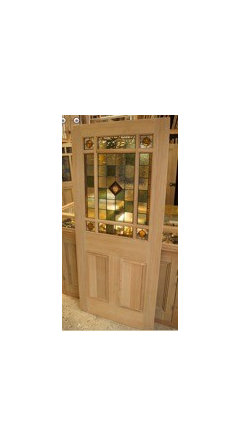Live Chat Series with George Clarke - January 19, at 3pm
Houzzers, you're in luck! George Clarke, architect and presenter of the very popular Restoration Man and Amazing Spaces series, will be joining our Houzz Live Chat series on Tuesday the 19th of January, at 3pm, to answer your questions.
The topic of the live chat is 'How to marry old and new when transforming a period property' - something we know many of you would like to know more about.
So if you're working on a project, are planning one, or are just struggling with making something work in your period property, submit your questions below!
The live chat is now over - thank you everyone for participating - especially George!

George Clarke is currently working on a TV series and if you live in a Victorian terrace, a Regency flat, or an Edwardian semi (or something even older!) - pay attention. The team are looking for homeowners who are about to start a period property project or already underway, so if you'd like the team to redesign your home, get in touch on info@amazingproductions.co.uk or call 07599 882 416.
Comments (100)
patriciaelsea
8 years agolast modified: 8 years agoHi George and Team,
We have recently purchased a Grade II listed 1840 Victorian semi in a conservation area in London. Our intention is to restore as many of the original features (fireplaces, shutters, etc) wherever possible and add a modern lower ground floor extension out the back to move the kitchen back downstairs and to include a family/TV area and utility. Because the house suffered some bomb damage in WW2 and was also used as a divided council property in the 1970s, the entire house needs to go back to its bones and start over again. Our biggest concer when thinking of design is the distinction between the two spaces and marrying the best features of period and modern. Do we have two clearly defined spaces (3 floors Victorian with modern furniture and a clearly modern lower ground floor)? How should we create the transition between upstairs/downstairs?
I've included some pictures of what it looks like today. I hope you can see the potential we do!



mendylent
8 years agohi George,
We are in the processing of buying a mid 17th century grade 2 listed house which would like to modernise inside whilst keeping the character of the building with exposed beams etc. I know there are restrictions even on interior modifications and want to know what is the best procedure. Is it worth going direct to the planner first to see what they will allow us to do or should we get a specialist architect/designer in first.
jonhodder
8 years agoHi George
Weve just finalised our first house purchase, which I will be looking to maximise its space. one thing im keen to learn is how to turn a house design/developer from passion to profession?
Emma Lewis
8 years agoHey George
'Slightly daunted and in need of help' from Bristol here! ...
We're in the planning stages of totally overhauling and extending (3 to 5 beds) a 1920's detached property on a hill with views.It has a quite steep, but lovely and large, back garden. Our plan is to work 'with' the garden slope and build bedrooms on the ground floor into the hill at the back. Living space will be on the first floor and have views over hills at the front and take you level to the garden at the back.
Marrying the fabric of the 1920's structure/features with modern materials eg glass/aluminium/etc is our dream ... but challenging as we'd like to retain the integrity of the old building whilst bringing it up to date for modern family living and carefully consider integrating the living space into the garden. Any ideas of how to tackle the design stage would be amazing, please.
We want to push the boundaries of possibility but work within sensible budgets, so creativity and ideas to create quirkiness are essential. We have some ideas but want to get it right ... We're up for anything at the moment!Over to 'Mr (wow) solutions', as you're known to us!
Meanwhile, good luck with your new series.
Many thanks and best wishes. Emma Lewis
(PS happy to send images if you're interested?)
helen r
8 years agoWe own a Victorian terrace - one of four cottages built for the railway workers around 1897 - planning permission has been granted for single storey extension at which point we are undertaking a full renovation at the same time - we are retaining the period features that are there, but modernising otherwise. Finding a builder is my challenge...
sophiect24
8 years agoGood Afternoon George and the team, we are looking to build next to a listed Victorian Farm building - in your view, is it better to compliment the historic building or contrast with modern design and materials? We would greatly appreciate your comments (let us know if you want photos or more info).
Thank you.
Brigitte Smith
8 years agoHello George I am not under any major construction but I would like some ideas after totally refurbishing decorating a period Lodge house I have one complete side of the lounge period wallpaper antique furniture On the other side of the room a 55 inch tv and modular for media which we have fitted into wall (no wires in sight) All looks great and I am happy with it so far but I need to somehow marry the two to come together your comments greatly appreciated
Thank you
Jenny Humphreys
8 years agoMorning! I have a generic question for George, as I start hunting for a cheap (and therefore probably small) period property to renovate. When a period property consists of various small rooms, what innovative ways have you seen or designed for creating either open plan living, or multi-functional rooms – and as an architect what’s your preference between these 2 different approaches?
heidipavlou123
8 years agoHello... not a period property, as I havent heard back from Grand designs would you be interested George Clarke in filming the first UK earthship syle house, it will be built on Sheppey and is due to start in April, we await conditions and begin an exciting year.... Heidi and Sav Pavlou.
letorres
8 years agolast modified: 8 years ago letorres's ideas · More Info
letorres's ideas · More Info
Hello, Back in March of 2014 we purchased a Victorian home that was built in the late 1890's by an architect named J. Alick Thomas for his family (he also designed a number of Churches in Sussex and Surrey). The home was divided into three properties by the last owners in the mid 80's. We managed to secure the main property but it was left in such a sorry state. We began the restoration process knowing the preservation of the building and it's original features were going to be costly. We managed to save and restore every sash and casement window including original hardware (there are around 50 in all). We have since updated the central heating, painted the exterior and remodelled the family bathroom. The rest of the house needs to be brought back to it's original glory but will also require an extension to fit a new kitchen. Being that the house itself is unique, we are trying to figure out how the extension can be integrated without ruining the integrity of the building. letorres's ideas · More Info
letorres's ideas · More InfoEmmeline Westin
Original Author8 years agolast modified: 8 years agoHello Houzzers! Thanks to everyone who posted their design dilemmas. Since we only have 40 minutes together we won’t be able to help all you, but we’ll do our very best. Let’s kick off the live chat and welcome George - thank you for joining us and sharing your expertise!
Don’t forget to keep refreshing the page to see new questions and answers!
We’ll start with the first question from @murshton - she has a 1930's semi that has been gutted and is now re-plastered. How does she reintroduce some period appropriate character in terms of skirting/archs and other moulding to restore its charm? What styles are most appropriate for that period?
Kent Blaxill
8 years agoHello George,
We've got a client who has a pantry on his period property that used to be an external loo. It was converted by sealing off the exterior door and knocking a hole through the wall. What would be the best brand to go to who could help him utilise that storage space to it's maximum potential? They'd be looking to install a very traditional looking kitchen with modern and intelligent storage ideas.
Thanks!George Clarke
8 years agoHi @murshton. There's a range of a style from this period, from Art Deco to Modernist and Contemporary, their unifying feature is simplicity. A 1930's semi is on the cusp of Art Deco and garden suburb housing. With these styles of houses, they tend to have distinctive skirting boards mouldings and details, so try and get your hands on a 1930's pattern book for inspiration. But they key to all of this is simplicity, so don't choose any details that are highly decorative or ornate. Good luck!
Emmeline Westin
Original Author8 years agoThanks George! Next question:
@rogggo is planning on renovating a period semi-detached property, and one of the things that concerns him is the solid brick walls and the lack of wall cavity, which will have a negative impact on energy performance. External insulation is not an option in order to preserve the beautiful facade of the property. Dry-lining will affect things like picture rails, cornices, coving, skirting, architrave etc. Can these be simply re-instated, or are there any other, less intrusive methods to achieve modern energy efficiency, without requiring the renewal of key period features?
Nicky Place
8 years agoHi George- we've just bought a beautiful victorian gothic house just outside leeds- its not in a bad way but rather dated & in need of TLC. It mainly requires renovation (minor remodelling- mainly installing a downstairs WC where there isnt one) but then an upgrade of kitchen bathroom etc . I'm having difficulty getting a building contractor but one in particular insisted we have an architect (their input would be minimal I think)- as an architect, do you think its vital?
The Honest Services Company
8 years agolast modified: 8 years ago- and another George....
We live in a 500+ year old cob cottage, on the watermeadows in Wiltshire - last July it was flooded (first time in living memory) due to the council not clearing the gullies in the street outside.
The builders are still putting it right, but there is an argument over the front room floors, which are about 12" below street level. I want to screw down the oak boards, then, if it floods again, the boards can be lifted washed - the under floor area can be disinfected - and everything put back. The builder wants to nail gun them down - because that is what he does. The insurance company are sort of backing me but as the boards have been nailed gunned down already - are reluctant to lift them again.
The water stayed in the house on the night of the flood for about an hour - it then drained away through the foundations - so the boards would only be soaked for that sort of period - I cannot believe solid real (not engineered) boards would be ruined in that time - and they would be salvageable - though may need re-polishing.
What is your advice?
Thanks
Adam
maxcope
8 years agoHi George thanks for doing this! I live in a weather-worn cobblestone cottage down on the South Coast and am thinking about bringing it into the 21st century and getting a modern extension - I'm just a little worried it won't work! What would you recommend and is there a way to sensitively bring an extension and period property together in an instance like this?
Thanks!
George Clarke
8 years agoHi @rogggo, dry-lining is without a doubt the easiest and most efficient way of insulating a period property. Obviously by doing this period details like skirting boards, architraves, picture rails and cornices will need to be removed and then reinstated. This is definitely possible, but can be an intensive job. In my view, to make your house fully insulated and as warm as possible this is definitely a job worth doing. If you're worried about this amount of work, then I suggest upgrade other parts of the house such as: double glazing your windows, insulating your loft, reducing heat-loss through draft excluders and regularly maintaining and possibly even upgrading your existing boiler. Basically being energy efficient with other elements of your house if you choose to not insulate the walls. Good luck!
Emmeline Westin
Original Author8 years agolast modified: 8 years agoWe've got quite a few questions coming through, which is great to see!
This one is from @FionaTownsend who wants to replace the internal doors in her Edwardian station masters semi, so that they let light into each room, especially the dining room, however she doesn’t want to compromise the 'feel' of the property. She’s asking if you could point her in the right direction of some glazed doors which retain the period features?
George Clarke
8 years agoHi Nicky Palace, even on a small scale project an architect can influence and inspire your refurbishment project by giving you ideas that you may never have thought of. It's always worth even paying for an architectural consultation to give you an idea of what's possible. If you like your architect, and the ideas they're coming up with, you could decide at that point to appoint them on the full project. Nothing much to lose, but hopefully a lot to gain by doing this. Good luck!
George Clarke
8 years agoHi @FionaTownsend, you're right internal doors can make a massive difference to the way a house or even a room feels. There's a huge range to choose from, but here are a few examples of some very smart glass panelled doors that may be appropriate for your house. Hopefully these will point you in the right direction.


Good luck!
Emmeline Westin
Original Author8 years agoHope that helps Fiona! We now have another Fiona who needs a bit of help.
@FionaO'Hanlon says that she’s in the latter stages of renovating a small 100m2 mid terrace three-storey Georgian property. She’s adding another 100m2 two-story extension. Her question relates to finish - should she mix or match, i.e put Regency doors, column radiators, etc. in the existing property and modern equivalents in the extension, or match them all throughout the property?
George Clarke
8 years agolast modified: 8 years agoHi @Maxcope, when adding a new extension onto a period property there are a number of routes you can go. One: you can design a traditional extension on your traditional building where all materials are the same or very similar. Two: you can design an extension that is contemporary and contrasts in every way to your period home. Three: or you can do a hybrid scheme, which can be contemporary or traditional with a twist... Meaning you can add new thoughts, ideas and details onto either scheme. But no doubt your local planning department will have a view and will give you steer on this. It sounds to me like you need the services of a good architect. Good luck!
George Clarke
8 years agoHi @FionaO'Hanlon, this all depends on the design and style of the new extension that's being added - if the extension is in more contemporary style, then it is possible to mix and match. Although my own personal view would be to tie the new extension in to the old, original property by using similar doors, radiators and details. This is all down to personal taste... Sometimes too much of a contrast doesn't work. Good luck!
Emmeline Westin
Original Author8 years agolast modified: 8 years agoOur time is nearly up, but we have a few more questions to go through!
@howardbrowning has an 18th Century Grade II listed thatched cottage in Bedfordshire that needs everything doing. They have planning permission to remove two poorly-built extensions and replace with new extensions, separate but close to the main building. They like the idea of linking the old to the new with glass links but have been told by a SPAB representative that they are seen as a 'bit cliche these days' and not liked by local authorities . What are your thoughts George?
Kent Blaxill
8 years ago@FionaTownsend We'd recommend having a look at Premdor - They do a fantastic range of internal and external doors.
Brigitte Smith
8 years agoHello George would like some ideas of blending old with new I have just finished refurbishing lounge one side is Victorian antique dilemma the other wall tv on wall no wires with floating modular under have you any suggestions in how I can marry the two on the wall ie to bring together many thanks
User
8 years agoHi George, I live in a 400+ year old farmhouse, mould is beginning to appear all over the house: on the back wall of wardrobes, on the walls around windows and in the bathrooms. Do you have any advice as to how we should take action? Thank you!
George Clarke
8 years agoHi @howardbrowning, linking new extensions to a period property is always a topic of intense debate in the world of restoration. A tried and tested method of doing this over the last ten years has been to create a minimal glazed link between the structures. I must admit I haven't heard myself that this is now 'a bit of a cliche'. The only other way of doing this would be to create a link that is ' in keeping' and in my view that could be regarded as being pastiche. A minimal link tends to work best as there is a clear distinction between old and new, which many conservation officers will be looking for. Saying that every building is unique, so make sure you consult wit your local planning and conservation officers to gain their advice. Good luck!
Emmeline Westin
Original Author8 years agoLast question now, our time is up! Thank you so much for taking the time to help Houzzers out, George. You've given us some really great advice!
@sophiect24 is looking to build next to a listed Victorian Farm building and wonders whether it's better to compliment the historic building or contrast with modern design and materials?
George Clarke
8 years agoThanks everyone for all your great questions! Really enjoyed it. Good luck with all of your interior refurbishments and restoration projects. If you have an interiors project that you're about to start and would like to be featured on my new series, George Clarke's House Rules, then please contact Amazing Productions info@amazingproductions.co.uk and I'll be on hand to help out. Thanks again! George x
jempearl
8 years agoHi Sarah,
I'm not as qualified as George but I lecture in construction and still do various building work. As a very simple fix for the Mould and damp problem, make sure you have sufficient ventilation. I have given advice on damp after people have been quoted ridiculous prices for expensive air conditioning units. Most the time they have been able to fix the problem with checking air bricks are cleared, windows have ventilation slots or moving wardrobes away from walls a bit to allow air flow. Give these cheap fixes a try before splashing out on more expensive solutions.
Kent Blaxill
8 years agolast modified: 8 years agoHi @Sarah,
@Jempearl is right, ventilation and air movement helps to dry out the problem areas and prevent further mould & mildew growth.
If you're looking to treat it then we'd recommend the following actions:
Get some mould killer. HG Mould Killer (available from most Kent Blaxill branches if you're in the East Anglia area) is a very powerful mould killing solution. Treat the mould with that and then let the area ventilate and dry out as much as possible.
To help inhibit the return of the mould, spray some Polycell Stain Block (aerosol) on the affected areas. This will help seal the mould and aid in covering the stains that mould leaves on walls.
Then we'd recommend painting with Zinsser Perma White - This paint is designed to be highly mould resistant. It's also available in an Eggshell for woodwork.
Hope this helps! Mould is a horrible issue and doing the above works for 95% of our customers.
Regards,
KB
User
8 years agoOh fantastic thank you @jempearl and @Kent Blaxill. I can't wait to try out the Polycell Stain Block, and I will definitely ensure better ventilation. Fingers crossed!
Thank you @George Clarke - what a great chat, so many useful tips!juliemullen
8 years agoHi George , We are turning a 1960s chalet bungalow into a house and need advise on white render. We live in Brighton and many rendered properties look bad with in 3 yrs!!! Or tips on a resin board for low maintanence. thanks.Julie
sophiect24
8 years agoHi Emmeline Westin- mine was the last question you presented to George- did it get a reply? I can't see it and v keen to get his feedback, thank you sophiect24
Emmeline Westin
Original Author8 years agoHi Sophie, George had to shoot off and missed your question! But I'll make sure it's answered by a pro on Houzz, so you can get some help. We'll try and do that for all of you who posted but didn't get your question answered!
VORBILD Architecture
8 years ago@mrushton : You could have a look here, this might give you some ideas : https://www.houzz.co.uk/magazine/ask-an-expert-how-to-mix-styles-and-eras-in-your-home-stsetivw-vs~47745470
DHV Architects
8 years agolast modified: 8 years agoDear @Alib70
If I understand correctly, you would like to re-build and raise the original (Victorian) pitch roof (rather than the flat roof addition), and carry out related improvements such as re-build the chimney stacks and lime render the elevations.
Planners will scrutinise very carefully any proposal that it is visible from the public realm, but since you state that the property is detached it might be possible to raise the roof line, subject to planning consent. The raised roof should be sympathetic to the style of the property and you might consider clay (rather than concrete) tiles and a traditional fascia detailing. Another consideration is to avoid overbearing on your neighbours' garden- this will depend on the roof height and the distance to the boundary. Planning consent will be required.
DHV Architects
8 years agolast modified: 8 years agoDear @judibutler
I assume you are referring to a wall which is wholly above ground and that you have completely ruled out damp tracking into the wall from above. A lot depends on the size and thickness of the wall and other factors, such as if the building is listed. Damp penetration (driving rain) through granite walls has been an ongoing problem in church towers in the southwest of England for some time. Ironically the problem often seems to get worse after re-pointing in lime. Granite is fairly impervious and was often in laid in large blocks meaning trapped water has little chance of getting out through thin mortar joints. Historic England held an excellent conference on the subject in 2013; the transcript of proceedings can be found at:
A roughcast lime render coat may help, but there could equally be voids in the wall which are holding damp and may need grouting. However, grouting is a very tricky and expensive technique which should not be undertaken lightly, and only works if one knows exactly where the voids are. Over-cladding the whole wall with semi-sacrificial weather boarding may be a last resort. This and rendering are likely to require planning consent.
Depending on where you are located, a company like ArchiMetric (www.archimetrics.co.uk) could insert some interstitial moisture monitors into the wall to try and find out exactly where and when the damp is getting in and how it is moving through the wall, but this may be expensive. Some localised investigation by dismantling pockets of stone may be useful. The Society of Ancient Buildings helpline (mornings only on 020 7456 0916) may be able to help with specialists in your area.
Most importantly try to get an understanding of how water is getting into and moving through your wall before you embark on anything. If your problems relate to below-ground damp then a different response will be needed.
maxcope
8 years agoThanks @GeorgeClarke - I really like the idea of a hybrid extension! Now let's see how that planning permission comes along... :/
Great chat!
VORBILD Architecture
8 years ago@ sophiect24 : Let me try and answer your query. If your building is listed and/or looks very traditional, and the changes you propose are not that big, I would suggest that the changes remain sympathetic to the building. In a way, I assume this was the reason why you bought it in the first place, to keep its character, or at least the majority of it.
Personally I prefer to see contemporary or very contemporary additions to the back, so that the appearance of the building remains traditional to the front. A new modern entrance might look good too.
I'm happy to give you more concrete answers - can you share some pictures of it please?
Janey Butler Interiors
8 years ago@sylviabarnes : Let me try to answer your query: 18C Cottage
When we work with clients own furniture (typically antiques or specific sentimental items), we then build our own style around these pieces.You need to be very careful, and to be honest takes a lot of experience to maximise to full effect.
With regard to mixing woods, this can be done, by typically only with flooring/windows being of one type and furniture another? Again to be honest, best stick to one wood per room .
Janey Butler Interiors
8 years ago@ARW AAW ; Let me try to answer your query : 14C Chateaux
We would always advise a good set of Architectural Plans and schedules which would highlight all of the points you raise, otherwise you will start waisting time and money from the start.
Basically, get your floor joists and boards sorted so you can work safely on each floor.Have all your internal walls formed, so that you can (from you detailed drawings) then accurately have the 1st fix of your plumbing and electrics installed. Ideally these contractors will know each other and be happy working together, if not, have your plumber do the pipe work first followed by the electrics.
Once this has been finished, windows can then be installed ready for plaster boarding/plastering before the 2nd fix stage.






rogggo